Heredity | Science - Book Back Questions with Answers | 10th Science : Chapter 18 : Heredity
Chapter: 10th Science : Chapter 18 : Heredity
Book Back Questions with Answers
Heredity (Science)
I. Choose the correct answer
1. According to Mendel alleles have the following character
a) Pair of genes
b) Responsible for character
c) Production of gametes
d) Recessive factors
2. 9 : 3 : 3 : 1 ratio is due to
a) Segregation
b) Crossing over
c) Independent assortment
d) Recessiveness
3. The region of the chromosome where the spindle fibres get attached during cell division
a) Chromomere
b) Centrosome
c) Centromere
d) Chromonema
4. The centromere is found at the centre of the ________________ chromosome.
a) Telocentric
b) Metacentric
c) Sub-metacentric
d) Acrocentric
5. The _____________ units form the backbone of the DNA.
a) 5 carbon sugar
b) Phosphate
c) Nitrogenous bases
d) Sugar phosphate
6. Okasaki fragments are joined together by ___________________.
a) Helicase
b) DNA polymerase
c) RNA primer
d) DNA ligase
7. The number of chromosomes found in human beings are __________________.
a) 22 pairs of autosomes and 1 pair of allosomes.
b) 22 autosomes and 1 allosome
c) 46 autosomes
d) 46 pairs autosomes and 1 pair of allosomes.
8. The loss of one or more chromosome in a ploidy is called ___________.
a) Tetraploidy
b) Aneuploidy
c) Euploidy
d) polyploidy
II. Fill in the blanks
1. The pairs of contrasting character (traits) of Mendel are called alleles.
2. Physical expression of a gene is called
3. The thin thread like structures found in the nucleus of each cell are called chromosomes.
4. DNA consists of two polynucleotide chains
5. An inheritable change in the amount or the structure of a gene or a chromosome is called mutation.
III. Identify whether the statement are True or False. Correct the false statement
1. A typical Mendelian dihybrid ratio of F2 generation is 3:1. - False
A typical mendelian dihybrid ratio of F2 generation is 9:3:3:1.
2. A recessive factor is altered by the presence of a dominant factor.
The expression of a recessive factor is altered by the presence of a dominant factor.
3. Each gamete has only one allele of a gene. - True
4. Hybrid is an offspring from a cross between genetically different parent.
5. Some of the chromosomes have an elongated knob-like appendages known as telomere.
Some of the chromosome have an elongated knob-like appendage known as satellite.
6. New nucleotides are added and new complementary strand of DNA is formed with the help of enzyme DNA polymerase.
7. DownŌĆÖs syndrome is the genetic condition with 45 chromosomes.
Down's syndrome is the genetic condition with 47 chromosmes.
IV. Match the following
1. Autosomes - Trisomy 21
2. Diploid condition - 9:3:3:1
3. Allosome - 22 pair of chromosome
4. DownŌĆÖs syndrome - 2n
5. Dihybrid ratio - 23rd pair of chromosome
Answer:
1. Autosomes - 22 pairs of chromosome
2. Diploid condition - 2n
3. Allosome - 23rd pair of chromosome
4. Downs syndrome - Trisomy 21
5. Dihybrid ratio - 9:3:3:1
V. Answer in a sentence
1. What is a cross in which inheritance of two pairs of contrasting characters are studied?
Dihybrid cross.
2. Name the conditions when both the alleles are identical?
Homozygous condition.
3. A garden pea plant produces axial white flowers. Another of the same species produced terminal violet flowers. Identify the dominant trait?
Position of flowers : Axillary position is dominant over terminal position of flowers.
Colour of flowers : White colour is dominant over violet colour.
4. What is the name given to the segments of DNA, which are responsible for the inheritance of a particular character?
Genes.
5. Name the bond which binds the nucleotides in a DNA.
Hydrogen bonds.
VI. Short answers questions
1. Why did Mendel select pea plant for his experiments?
(i) It is naturally self-pollinating and so is very easy to raise pure breeding individuals.
(ii) It has a short life span as it is an annual and so it was possible to follow several generations.
(iii) It is easy to cross-pollinate.
(iv) It has deeply defined contrasting characters.
(v) The flowers are bisexual.
2. What do you understand by the term phenotype and genotype?
External expression of a particular trait is known as phenotype. A genotype is the genetic expression of an organism
3. What are allosomes?
(i) Allosomes are chromosomes which are responsible for determining the sex of an individual.
(ii) They are also called as sex chromosomes or hetero - chromosomes.
(iii) There are two types of sex chromosomes, X and Y- chromosomes.
4. What are Okazaki fragments?
During the replication of a DNA molecule, the new strand is synthesized in short segments which are called Okazaki fragments. There are joined together by the enzyme DNA ligase.
5. Why is euploidy considered to be advantageous to both plants and animals?
(i) Euploid plants often result in increased fruit and flower size. Therefore it is advantageous for them.
(ii) The euploid animals are sterile.
6. A pure tall plant (TT) is crossed with pure dwarf plant (tt), what would be the F1 and F2 generations? Explain.
Crosses involving inheritance of only one pair of contrasting characters are called monohybrid cross.
Cross between pure tall (TT) plant and Pure dwarf (tt) plant
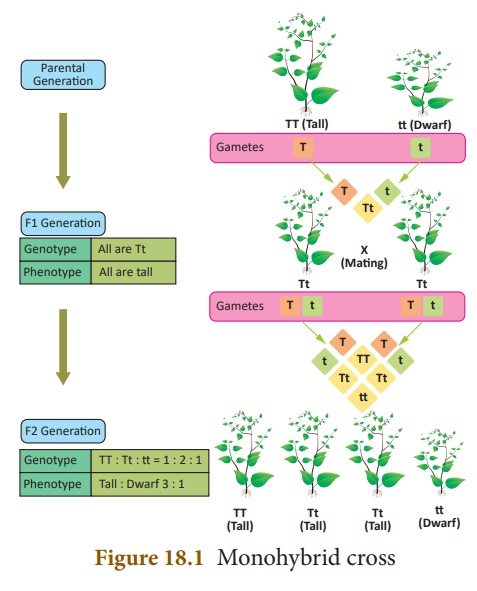
Parental Generation : Pure breeding Tall and dwarf plants are crossed (TT x tt).
F1 Generation : Monohybrids are heterozygous tall.
F2 Generation : Selfing of the F1 monohybrids takes place. Tall and dwarf plants are obtained in the ratio of 3:1 which is the phenotypic ratio. Genotypically plants are of three types as shown above and therefore genotypic ratio is 1:2:1.
7. Explain the structure of a chromosome.
(i) The chromosomes are thin, long and thread like structures consists of two identical strands called sister chromatids.
(ii) They are held together by the centromere.
(iii) Each chromatid is made up of spirally coiled thin structure called chromonema. The chromonema has number of bead-like structures along its length which are called chromomeres.
(iv) The chromosomes are made up of DNA, RNA, chromosomal proteins (histones and non-histones) and certain metallic ions. These proteins provide structural support to the chromosome.
A chromosome consists of the following regions:
Primary constriction : The two arms of a chromosome meet at a point called primary constriction or centromere. The centromere is the region where spindle fibres attach to chromosomes during cell division.
Secondary constriction : Apart from the primary constriction, some chromosomes possess secondary constriction at any point of the chromosome. They are known as the nuclear zone or nucleolar organizer (formation of nucleolus in the nucleus).
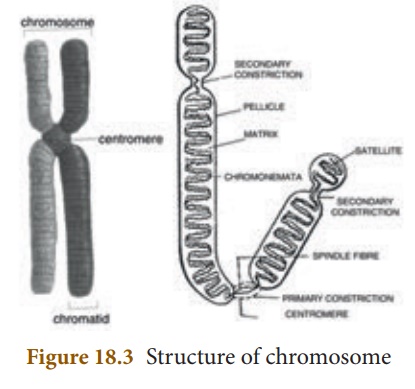
Telomere : The end of the chromosome is called telomere. It maintains and provides stability to the chromosomes.
Satellite : Some of the chromosomes have an elongated knob-like appendage at one end of the chromosome known as satellite. The chromosomes with satellites are called as the sat-chromosomes.
8. Label the parts of the DNA in the diagram given below. Explain the structure briefly.
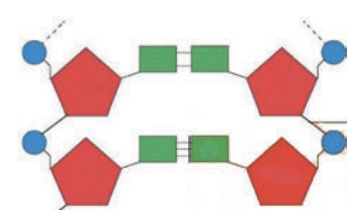
Watson and Crick model of DNA:
(i) DNA molecule consists of two polynucleotide chains.
(ii) These chains form a double helix structure with two strands which run anti-parallel to one another.
(iii) Nitrogenous bases in the centre are linked to sugar-phosphate units which form the backbone of the DNA.
(iv) Pairing between the nitrogenous bases is very specific and is always between purine and pyrimidine linked by hydrogen bonds.
Ōśģ Adenine (A) links Thymine (T) with two hydrogen bonds (A = T)
Ōśģ Cytosine (C) links Guanine (G) with three hydrogen bonds( C = G)
This is called complementary base pairing.
(v) Hydrogen bonds between the nitrogenous bases make the DNA molecule stable.
(vi) Each turn of the double helix is 34 A┬░ (3.4 nm). There are ten base pairs in a complete
(vii) The nucleotides in a helix are joined together by phosphodiester bonds.
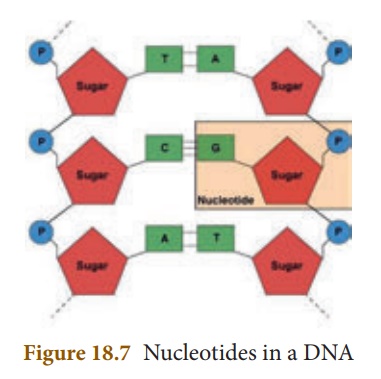
Nucleotides in a DNA
P - Phosphate
A - Adenine
G - Guanine
T- Thymine
C - Cytosine
VII. Long answer questions
1. Explain with an example the inheritance of dihybrid cross. How is it different from monohybrid cross?
Answer:
Dihybrid
cross involves the inheritance of two pairs of contrasting
characteristics (or contrasting traits) at the same time. The two
pairs of contrasting characteristics chosen by Mendel were shape and colour of seeds: round-yellow seeds and wrinkled-green seeds.
(i) Mendel first crossed pure breeding pea plants
having round-yellow seeds with pure breeding pea plants having wrinkled-green
seeds and found that only round-yellow seeds were produced in the first
generation (F1).
(ii) From this it was concluded that round shape and
yellow colour of the seeds were dominant traits over the wrinkled shape and
green color of the seeds.
(iii) When the hybrids of F1 generation pea
plants having round-yellow seeds were cross-bred by self pollination, then four
types of seeds having different combinations of shape and color were obtained
in second generation or F2 generation. They were round yellow, round-green, wrinkled yellow and wrinkled-green seeds.
(iv) The ratio of each phenotype (or appearance) of
seeds in the F2 generation is
9:3:3:1. This is known as the Dihybrid
ratio.
(v) From the above results it can be concluded that
the factors for each character or trait remain independent and maintain their
identity in the gametes. The factors are independent to each other and pass to
the offsprings (through gametes).
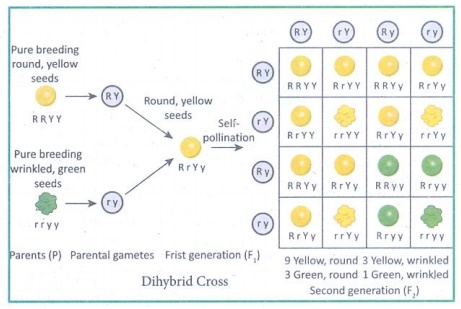
Results of a Dihybrid Cross: Mendel got the following
results from his dihybrid cross:
(i) Four types of plants: A dihybrid cross produced four
types of F2 offsprings in the ratio of 9 with two dominant traits, 3
with one dominant trait and one recessive trait, 3 with another dominant trait
and another recessive trait and 1 with two recessive traits.
(ii) New combination: Two new combinations of traits
with round green and wrinkled yellow had appeared in the dihybrid cross (F2
generation).
P. Herence between dihybrid of monohybrid uses :
(i) Dihybrid cross is different from a monohybrid
cross because it involves inheritance of two pairs of contrasting characters.
In monohybrid cross, only inheritance of 1 pair of contrasting character is
studied.
(ii) Further results of monohybrid cross is based on
two alleles of a gene.
(iii) Results of dihybrid cross is based on two
different genes controlling two different characters and their alleles.
2. How is the structure of DNA organised? What is the biological significance of DNA?
Answer:
Structure of DNA : The most widely accepted model
of DNA is the double helical structure of James Watson and Francis Crick.
Chemical Composition of DNA molecule : DNA is a
large molecule consisting of millions of nucleotides. Hence, it is also called
a polynucleotide. Each nucleotide consists of three components.
(i) A sugar molecules - Deoxyribose sugar.
(ii) A nitrogenous base.
There
are two types of nitrogenous bases in DNA. They are
(a) Purines (Adenine and Guanine)
(b) Pyrimidines (Cytosine and Thymine)
(iii) A phosphate group
Nucleoside and Nucleotide :
Nucleoside
= Nitrogen base + Sugar
Nucleotide
= Nucleoside + Phosphate
The
nucleotides are formed according to the purines and pyrimidines present in
them.
Watson and Crick model of DNA :
(i) DNA molecule consists of two polynucleotide chains.
(ii) These chains form a double
helix structure with two strands which run anti-parallel to one another.
(iii) Nitrogenous bases in the centre are linked to sugar-phosphate units which form the backbone
of the DNA.
(iv) Pairing between the nitrogenous bases is very
specific and is always between purine and pyrimidine linked by hydrogen bonds.
ŌŚÅ
Adenine (A) links Thymine (T) with two hydrogen bonds (A = T)
ŌŚÅ
Cytosine (C) links Guanine (G) with three hydrogen bonds( C ŌēĪ G)
This
is called complementary base pairing.
(v) Hydrogen bonds between the nitrogenous bases make
the DNA molecule stable.
(vi) Each turn of the double helix is 34 A┬░ (3.4 nm).
There are ten base pairs in a complete turn.
(vii) The nucleotides in a helix are joined together by
phosphodiester bonds.
Significance of DNA:
(i) It is responsible for the transmission of
hereditary information from one generation to next generation.
(ii) It contains information required for the
formation of proteins.
(iii) It controls the developmental process and life
activities of an organism.
3. The sex of the new born child is a matter of chance and neither of the parents may be considered responsible for it. What would be the possible fusion of gametes to determine the sex of the child?
Answer:
(i) Human beings have 23 pairs of chromosomes out of
which 22 pairs are auto somes and one pair (23rd pair) is the sex chromosome.
(ii) The female gametes or the eggs formed are similar
in their chromosome type (22 + X). Therefore, human females are homogametic.
(iii) The male gametes or sperms produced are of two
types.
(iv) The sperm bearing (22+X) chromosomes and the
sperm bearing (22+Y) chromosomes. The human males are called heterogametic.
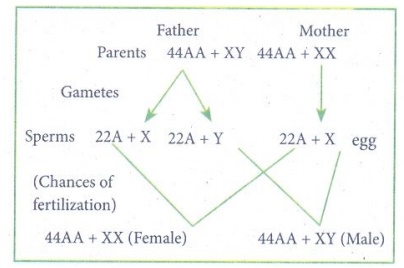
(v) It is a chance of probability as to which type of
sperm fuses with the egg.
(vi) If the egg (X) is fused by the X-bearing sperm an
XX individual (female) is produced.
(vii) If the egg (X) is fused by the Y-bearing sperm an
XY individual (male) is produced.
(viii) The sperm, produced by the father, determines the sex of the child. The mother is not responsible in determining the sex of the child.
VIII. Higher Order Thinking Skills (HOTS)
1. Flowers of the garden pea are bisexual and self-pollinated. Therefore, it is difficult to perform hybridization experiment by crossing a particular pistil with the specific pollen grains. How Mendel made it possible in his monohybrid and dihybrid crosses?
Mendel selected the plants to be used as male and female parent. He removed the stamen from the flower of the plant which was taken up as the female parent. Self pollination will not be possible in this flow. Further he also kept the stigma covered so that no other pollen other than the desired variety will fall on the stigma. Thus mendel was above 40 percent self pollination in the plants selected for crossing.
2. Pure-bred tall pea plants are first crossed with pure-bred dwarf pea plants. The pea plants obtained in F1 generation are then cross-bred to produce F2 generation of pea plants.
a. What do the plants of F1 generation look like?
b. What is the ratio of tall plants to dwarf plants in F2 generation?
c. Which type of plants were missing in F1 generation but reappeared in F2 generation?
(a) The plants of the F1 generation will be tall.
(b) The ratio of tall: dwarf plants (phenotypic ratio) will be 3:1 in the F2 generation.
(c) The- dwarf plants were missing in the F1 generation but reappeared, in F2 generation.
3. Kavitha gave birth to a female baby. Her family members say that she can give birth to only female babies because of her family history. Is the statement given by her family members true. Justify your answer.
No. The statement given by her family members is false. The birth of male or female babies is by random combination of a sperm and egg. Sperms are of two kinds based on sex chromosome (X chromosome &Y chromosome). The eggs always have only X chromosome (sex chromosomes).
If a sperm with X chromosome fuses with an egg, a girl baby is born.
If a sperm with Y chromosome fuses with an egg, a boy baby is born. The sex of the baby depends on the type of sperm which fertilizes the ovum.
IX. Value based question
1. Under which conditions does the law of independent assortment hold good and why?
Law of independent assortment:
The law was proposed based on dihybrid cross. The cross involves the inheritance of two pairs of contrasting characters at the same time.
(i) Each character is determined by a pair of alleles. (Dominant and recessive).
(ii) Each allele is contributed by a parent to the offspring.
(iii) The results of the dihybrid cross performed by Mendel showed 4 combination of characters in the ratio of 9 : 3 : 3 : 1.
(iv) It can be concluded that the factors for each character or trait remain independent and maintain their identity in the gametes. The factors are independent to each other and pass to the offsprings (through gametes).
Therefore the conditions for the law of Independent Assortment are:
(a) Each trait is determined by a pair of alleles.
(b) The inheritance of all the alleles governing the two traits must be independent of each other.
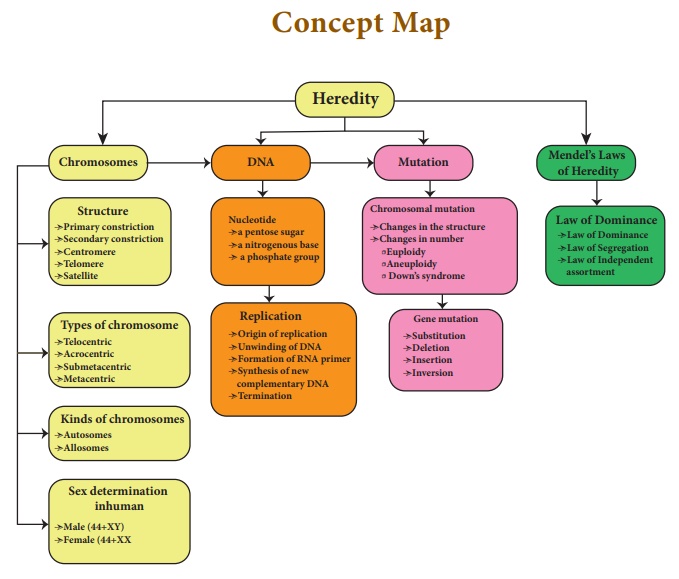
Related Topics